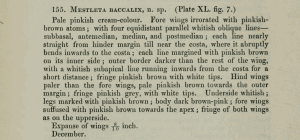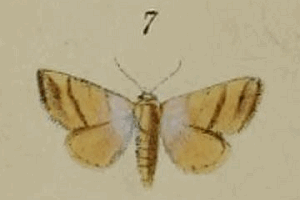Version 22 (neueste) vom 8. August 2023 um 23:21:45 von Erwin Rennwald
Länder:

 +5Kontinente:ASOC
+5Kontinente:ASOC


 +5Kontinente:ASOC
+5Kontinente:ASOCInhalt
2. Diagnose
2.1. Erstbeschreibung
1-2: Swinhoe (1886: 452, pl. XL fig. 7) [nach Copyright-freien Scans auf www.biodiversitylibrary.org]
3. Weitere Informationen
3.1. Andere Kombinationen
- Mestleta baccalix Swinhoe, 1886 [Originalkombination]
3.2. Synonyme
- Mestleta fasciosa Moore, [1887]
3.3. Taxonomie und Faunistik
Die Art wurde aus Indien beschrieben und später auch aus Afrika und von den Kanarischen Inseln angeführt. Hacker (2019) - zitiert nach Knapp et al. (2022) - trennte die Tiere aus Afrika (inklusive der Kanaren) aber als eigene Art - Eublemma baccatrix - ab (mit einer Barcoding-Distanz von immerhin 4,6 %!). Zum Areal von E. baccalix heiß es bei ihnen: "[...] whereas E. baccalix limits its distribution to India and adjacent territories, Taiwan, New Caledonia and Fiji Islands (Hacker, 2019)."
(Autor: Erwin Rennwald)
3.4. Literatur
- Hacker, H. H. (2019): Systematic and illustrated catalogue of the Heterocera (Lepidoptera) of Africa, 1. Biogeography. Boletobiinae (Erebidae). — Moths of Africa 1: 1-815. [Sekundärzitat nach Knapp, Grundy, Ortiz & Yela (2022)]
- Knapp, S., Grundy, D., Ortiz, A. W. & J. L. Yela (2022): Eublemma baccatrix Hacker, 2019 (Lepidoptera: Erebidae: Boletobiinae: Eublemmini), new for the Iberian Peninsula and Europe. Eublemma baccatrix Hacker, 2019 (Lepidoptera: Erebidae: Boletobiinae: Eublemmini), nueva para la península ibérica y Europa. — Arquivos Entomolóxicos 25: 293-297. [PDF auf aegaweb.com]
- Erstbeschreibung: Swinhoe, C. (1886): On the Lepidoptera of Mhow, in Central India. — Proceedings of the scientific meetings of the Zoological Society of London for the year 1886: 421-465, pl. XL-XLI.








